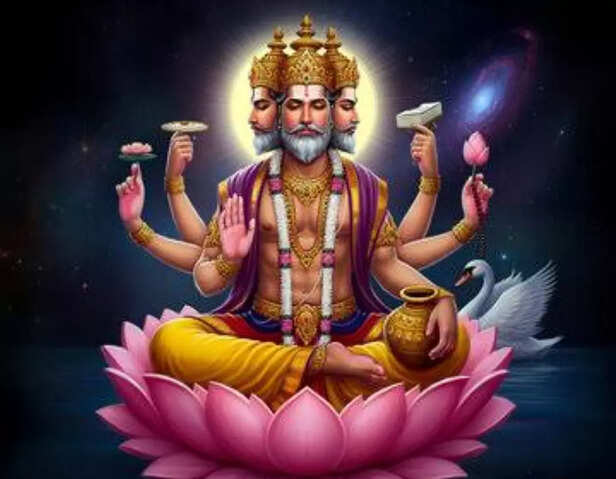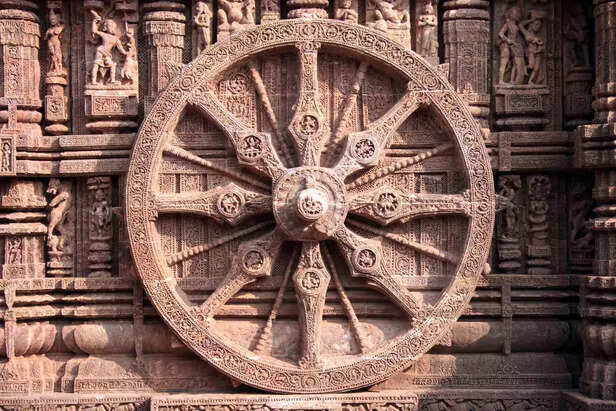Brahma Only Lives For 100 Years?
Ankit Gupta | May 24, 2025, 23:53 IST
Brahma-The Creator
( Image credit : Freepik )
In Hindu cosmology, Brahma, the creator, lives for just 100 years — but those aren't Earth years. According to the Vishnu Purana, one day of Brahma equals 8.64 billion Earth years. His entire lifespan? A staggering 311 trillion Earth years. This isn’t science fiction — it’s sacred cosmology.
“Sahasra-yuga-paryantam ahar yad brahmaṇo viduḥ, rātriṁ yuga-sahasrāntāṁ te 'ho-rātra-vido janāḥ”
– Bhagavad Gita 8.17
(“Those who understand the cosmic day and night know that one day of Brahma lasts a thousand Yugas, and so does his night.”)

Time is a mystery that has puzzled human consciousness for ages. In the modern scientific world, time is mostly seen as linear — measured in seconds, years, and light-miles. Yet in ancient Hindu cosmology, time is not just a quantity to be measured but a quality of existence — cyclical, sacred, and alive.
At the heart of this cosmic vision lies Brahma, the creator god of the Hindu trinity. His lifespan, seemingly just 100 years, is not trivial. Rather, it is immeasurably vast, equating to 311.04 trillion Earth years. This divine lifespan serves not merely as mythology but as a cosmic calendar, orchestrating the rhythm of creation and destruction, sustaining the universe in cycles that transcend comprehension.
This essay explores the profound significance of Brahma's hundred-year lifespan — what it means symbolically, cosmologically, spiritually, and why it still matters in today’s philosophical quest for understanding the universe.

Brahma, in Hindu cosmology, is not the Supreme God — that role is often ascribed to Brahman (the formless, eternal truth), Vishnu (the preserver), or Shiva (the dissolver). Brahma is the engineer of the cosmos, the mind through which the manifest world takes form.
He is born from a lotus emerging from Vishnu’s navel at the dawn of each universal cycle. His duty is to create all beings, matter, and time itself. Yet, he is also mortal, in a divine sense. His lifespan is vast, but not eternal. After 100 divine years, Brahma dies — and a new Brahma is born from Vishnu again.
This idea is not symbolic of mere longevity but reflects a deeply sophisticated understanding of impermanence, cyclical time, and cosmic breath.
The Vishnu Purana, Bhagavata Purana, and Bhagavad Gita all outline the grand scale of Brahma’s time. Let's break it down:
A single Yuga Cycle is made of four Yugas:
One day of Brahma = 1,000 Yuga Cycles = 4.32 billion years
Brahma’s night is of equal duration: another 4.32 billion years of cosmic dissolution (pralaya).
A Brahma year has 360 days (each with a day and night), making:
360 × 8.64 billion = 3.1104 trillion Earth years
100 Brahma years = 311.04 trillion Earth years
This immense duration illustrates the cyclic and non-linear understanding of time in Hindu thought — the universe isn’t created once and for all but goes through infinite births and dissolutions.
According to many Hindu scriptures, including the Srimad Bhagavatam, we are currently in the first day of Brahma’s 51st year. That means Brahma is halfway through his life — a symbolic midpoint in the cosmic breath cycle.
Within this day, we are in the 28th Kali Yuga of the 7th Manvantara. This implies:

Even the creator must perish. Brahma’s 100-year lifespan reminds us that creation itself is impermanent, no matter how vast or divine. Nothing material or manifest escapes the eventual pull of dissolution.
Brahma’s days and nights mirror the cycle of birth and death in individual lives. Just as Brahma wakes and sleeps, so too does the human soul cycle through lives — until liberation (moksha) is attained.
In Abrahamic traditions, creation is often viewed as a one-time event. In Hinduism, however, creation is rhythmic, repeating like seasons or breaths. The death of Brahma is not the end — it’s the beginning of a new cosmic cycle. This is Sanatan Dharma — the eternal order, which never truly begins or ends.
Placed next to a 311 trillion-year lifespan, the average human life feels minuscule. Yet, paradoxically, Hindu cosmology doesn’t make you feel insignificant. Instead, it offers a deeper truth: You are not your body; you are Atman, the soul, which is eternal — even beyond Brahma’s hundred years.
Western science, with the Big Bang as its central creation theory, sees time as a line with a beginning and possible end. Hindu cosmology, on the other hand, proposes a cyclical model — the universe is born, lives, dissolves, and is reborn, ad infinitum.
This is not primitive thinking but a deeply existential and spiritual interpretation of impermanence and eternity coexisting.
The concept of Brahma’s lifespan introduces multiple planes of reality:
Brahma is not worshipped widely in Hinduism, and there's a reason. His role is functional, not absolute. Creation is an ongoing process, not a divine miracle. Brahma’s lifespan illustrates that even gods have duties and limits — only the formless Brahman is beyond time.
At the end of Brahma’s hundredth year, the entire manifested cosmos — not just galaxies and planets but all dimensions, subtle and gross — is said to be dissolved into the Mahapralaya, or Great Dissolution.
It is fascinating to observe that modern cosmology, too, is contemplating cyclic universes. Theories like the Big Bounce, Oscillating Universe, and Multiverse Hypothesis suggest that the universe might not be a one-time event.
In fact, the estimated age of the current universe — about 13.8 billion years — intriguingly aligns with one day of Brahma (8.64 billion years). Could it be symbolic intuition reflecting deep cosmic truths that modern science is only beginning to uncover?
While Hindu cosmology is not empirical science, it offers metaphysical frameworks that science increasingly resonates with, especially in areas like quantum mechanics, relativity, and cosmogenesis.
In a world obsessed with immediacy — social media cycles, 24-hour news, 10-minute meditations — Brahma’s lifespan offers perspective.
Brahma’s hundred years are not just about immense numbers — they are about profound truths. They challenge our ideas of time, creation, and permanence. They invite us to step back from the ego of the moment and gaze upon the canvas of cosmic eternity.
In the silence between Brahma’s breath — between one universe ending and another beginning — lies the great stillness of Brahman, the unchanging reality.
And in knowing this, we too can learn to live with awe, humility, and wisdom — not as fleeting beings racing against time, but as timeless souls witnessing the dance of divine cycles.
– Bhagavad Gita 8.17
(“Those who understand the cosmic day and night know that one day of Brahma lasts a thousand Yugas, and so does his night.”)
Time as Divinity

Time has always been an illusion
( Image credit : Pixabay )
Time is a mystery that has puzzled human consciousness for ages. In the modern scientific world, time is mostly seen as linear — measured in seconds, years, and light-miles. Yet in ancient Hindu cosmology, time is not just a quantity to be measured but a quality of existence — cyclical, sacred, and alive.
At the heart of this cosmic vision lies Brahma, the creator god of the Hindu trinity. His lifespan, seemingly just 100 years, is not trivial. Rather, it is immeasurably vast, equating to 311.04 trillion Earth years. This divine lifespan serves not merely as mythology but as a cosmic calendar, orchestrating the rhythm of creation and destruction, sustaining the universe in cycles that transcend comprehension.
This essay explores the profound significance of Brahma's hundred-year lifespan — what it means symbolically, cosmologically, spiritually, and why it still matters in today’s philosophical quest for understanding the universe.
Who Is Brahma?

शुद्धं बुद्धं महाप्रज्ञामण्डितम् रणपण्डितम् ।
( Image credit : Freepik )
Brahma, in Hindu cosmology, is not the Supreme God — that role is often ascribed to Brahman (the formless, eternal truth), Vishnu (the preserver), or Shiva (the dissolver). Brahma is the engineer of the cosmos, the mind through which the manifest world takes form.
He is born from a lotus emerging from Vishnu’s navel at the dawn of each universal cycle. His duty is to create all beings, matter, and time itself. Yet, he is also mortal, in a divine sense. His lifespan is vast, but not eternal. After 100 divine years, Brahma dies — and a new Brahma is born from Vishnu again.
This idea is not symbolic of mere longevity but reflects a deeply sophisticated understanding of impermanence, cyclical time, and cosmic breath.
The Measurement of Divine Time
1. Yuga Cycle
- Satya Yuga – 1.728 million years
- Treta Yuga – 1.296 million years
- Dvapara Yuga – 864,000 years
- Kali Yuga – 432,000 years
2. 1 Day of Brahma (Kalpa)
Brahma’s night is of equal duration: another 4.32 billion years of cosmic dissolution (pralaya).
3. 1 Year of Brahma
360 × 8.64 billion = 3.1104 trillion Earth years
4. Brahma’s Full Lifespan
This immense duration illustrates the cyclic and non-linear understanding of time in Hindu thought — the universe isn’t created once and for all but goes through infinite births and dissolutions.
Where Are We Now?
Within this day, we are in the 28th Kali Yuga of the 7th Manvantara. This implies:
- 6 Manvantaras are complete (each Manvantara is ~71 Yuga Cycles)
- We are in the Kali Yuga (the age of darkness and spiritual degradation), believed to have begun roughly 5,000 years ago, and set to last 432,000 years total.
Symbolism of Brahma’s Lifespan

Concept of Time in Hinduism
( Image credit : Pexels )
1. Impermanence of Creation
2. The Cycle of Samsara
3. Creation Is Not Eternal
4. Human Insignificance – and Divinity
Philosophical Implications
A. Time Is Not Linear, But Cyclical
This is not primitive thinking but a deeply existential and spiritual interpretation of impermanence and eternity coexisting.
B. Reality Is Layered
- Our perception (Earth time)
- Cosmic time (Yuga time)
- Divine time (Brahma time)
C. The Divine as a Process, Not a Person
The Dissolution of Brahma
- Brahma dies.
- All universes collapse into Vishnu’s causal ocean.
- The unmanifest state remains — pure potential.
Scientific Parallels and Reflections
In fact, the estimated age of the current universe — about 13.8 billion years — intriguingly aligns with one day of Brahma (8.64 billion years). Could it be symbolic intuition reflecting deep cosmic truths that modern science is only beginning to uncover?
While Hindu cosmology is not empirical science, it offers metaphysical frameworks that science increasingly resonates with, especially in areas like quantum mechanics, relativity, and cosmogenesis.
Why It Matters Today
- Patience in Time – Not everything needs to happen in one lifetime. Evolution, both cosmic and spiritual, is a slow dance.
- Humility – Our achievements and crises, though urgent to us, are often ripples in the vast ocean of time.
- Eternal Hope – Even after death, darkness, and destruction, there’s always a new beginning. Just as Brahma is reborn, so too is everything.
- The True Self is Beyond Time – The Atman is timeless. Understanding cosmic time helps one realize their eternal essence, and not remain stuck in temporal fears.
The Breath of the Infinite
In the silence between Brahma’s breath — between one universe ending and another beginning — lies the great stillness of Brahman, the unchanging reality.
And in knowing this, we too can learn to live with awe, humility, and wisdom — not as fleeting beings racing against time, but as timeless souls witnessing the dance of divine cycles.
